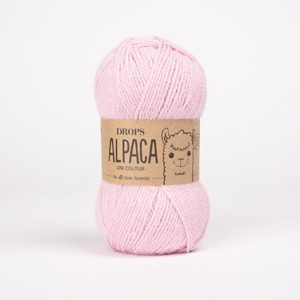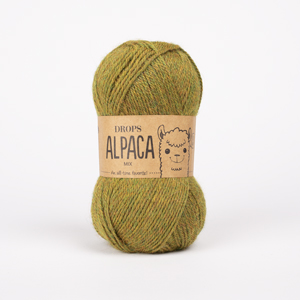Comments / Questions (90)
![]() Doreen Vels Jacobs wrote:
Doreen Vels Jacobs wrote:
Klopt het dat bij de drops 136-13 de minderingen in de zij bij de rug en voorhanden op verschillende hoogtes zijn Rug bij 10 en 20 cm. Bij de voorpanden 15 en 25 cm?
13.08.2024 - 23:02DROPS Design answered:
Dag Doreen,
Ja, dat klopt. Dit is bewust gedaan, zodat je na het in elkaar zetten niet op één plek in de zijnaad ineens een heel groot verschil ziet, maar dat het meer verdeeld is.
16.08.2024 - 17:20
![]() Lorraine Shepherd wrote:
Lorraine Shepherd wrote:
Is the pattern written for a UK or US treble crochet? I am doing the UK one but it doesn’t seem to be making a large enough pattern.
25.09.2023 - 21:18DROPS Design answered:
Dear Mrs Shepherd, pattern is available in both language, but with treble crochets in UK-English - try with a larger crochet hook size if you have too few stitches/rows for the tension - read more here. Happy crocheting!
26.09.2023 - 11:22
![]() Carmen wrote:
Carmen wrote:
Hola, no entiendo las instrucciones de las disminuciones después de la sisa de las mangas para una talla L, ya que dice que se disminuye 1 repetición y luego 1/2 repetición 0 veces. Luego salen otros números y veces, ahí me perdí y no entiendo. Gracias 😁
09.01.2022 - 05:57DROPS Design answered:
Hola Carmen, si pone 0 significa que para esa talla no se tienen que trabajar disminuciones. Para la talla L, en la manga, solo disminuimos 8 veces a cada lado en cada fila. Tienen que quedarte al final 6 repeticiones.
10.01.2022 - 19:25
![]() Nancy wrote:
Nancy wrote:
Hello I want to make sure that i understand this part (dec for armholes in each side on every row as follows: 1 repetition 1-1-2-2-2-2 times, then ½ repetitions 0-2-2-2-4-4 times = 15-15-15-17-17-19 repetitions. When piece measures 52-54-56-58-60-62 cm) so i'll put it in steps : 1- work 1 repetition 1 time (x.1) 2- work 1/2 repetition 2 times (x.2) 3- work (m.1) until piece measures 54 cm So these steps are right or did i misunderstood??
12.08.2021 - 20:44DROPS Design answered:
Dear Nancy, that's exactly how to crochet in size M. Happy crocheting!
13.08.2021 - 07:26
![]() Nancy wrote:
Nancy wrote:
I did the first dec. after 10 cm Then how should i continue working is it using the M.1 or x.2
08.08.2021 - 19:51DROPS Design answered:
Dear Nancy, after decreasing, start and end the row as shown in X.2 and continue inbetween as before (in M.1 = middle of X.2). Happy crocheting!
09.08.2021 - 08:17
![]() Els Van Zantvliet wrote:
Els Van Zantvliet wrote:
Dank je wel voor de info
21.03.2021 - 10:57
![]() Els Van Zantvliet wrote:
Els Van Zantvliet wrote:
Waarom minder je bij het achterpand bij 10 cm en 20 cm en bij het voorpand bij 15 cm en 25 cm?
20.03.2021 - 22:15DROPS Design answered:
Dag Els,
Dit wordt gedaan om de minderingen verdeeld over de zijnaad te krijgen, als je ze op dezelfde hoogte doet, zou je een verspring kunnen krijgen op die plek na het in elkaar naaien.
21.03.2021 - 10:41
![]() Fiorella Catters wrote:
Fiorella Catters wrote:
Grazie mille 😘
13.09.2020 - 14:26
![]() Fiorella Carrera wrote:
Fiorella Carrera wrote:
Forse non mi sono spiegata se il lavoro misura 10 non può misurare anche 20 cm ? Oppure 10 per quale taglia?
10.09.2020 - 16:55DROPS Design answered:
Buongiorno Fiorella. Deve diminuire quando il lavoro misura 10 cm (per tutte le taglie) e poi quando il lavoro misura 20 cm (per tutte le taglie). Buon lavoro!
10.09.2020 - 17:34
![]() Carrera Fiorella wrote:
Carrera Fiorella wrote:
Per favore non mi è chiaro nel dietro e davanti’ quando il lavoro misura 10 e 20 centimetri ‘ diminuire 1/2 ripetizioni per lato (dietro) e quando il lavoro misura 15 e 25 cm ecc.
09.09.2020 - 16:30DROPS Design answered:
Buongiorno Fiorella. Per diminuire una mezza ripetizione, deve lavorare 3 maglie bassissime sulle prime tre m della riga e finire la riga 3 maglie prima. La penultima riga del diagramma X.2 può aiutare a capire meglio come lavorare. Buon lavoro!
10.09.2020 - 16:30
Whispers#whisperscardigan |
||||||||||
 |
 |
|||||||||
Crochet DROPS jacket in ”Alpaca”. Size: S - XXXL.
DROPS 136-13 |
||||||||||
|
CROCHET INFO: Replace first dc at beg of row with ch 3. PATTERN: See diagram M.1. Repeat row 1 and 2. M.1 shows 3 repeats in width and 1 repeat in height. MEASURING TIP: The garment will be longer because of pattern. All measurements must therefore be done while holding up the garment. DECREASE TIP: Dec 1 repetition in diagram X.1, or ½ repetition in diagram X.2. Dec at beg of row as follows: Replace 1 repetition with 6 sl st and ½ repetition with 3 sl st. Dec at end of row as follows: Turn piece when either 1 or ½ repetition remains. INCREASE TIP (applies to sleeve): Inc ½ repetition. Inc by turning with 6/7 ch instead of 3, see diagram X.3. -------------------------------------------------------- -------------------------------------------------------- BACK PIECE: Ch 120-132-144-156-168-180 (includes 8 ch to turn with) on hook size 3.5 mm/E/4 with blue. Work 1 dc in the 9th ch from hook, * ch 2, skip ch 2, 1 dc in next ch *, repeat from *-* = 39-43-47-51-55-59 dc. Continue to work diagram M.1 (1st row is now done, beg on 2nd row) = 19-21-23-25-27-29 repetitions. When piece measures 10 and 20 cm / 4" and 8" - Read MEASURING TIP, dec ½ repetition in each side – read DECREASE TIP and see diagram X.2 = 17-19-21-23-25-27 repetitions. When piece measures 35-36-37-38-39-40 cm / 13¾"-14¼"-14½"-15"-15¼"-15¾", dec for armholes in each side on every row as follows: 1 repetition 1-1-2-2-2-2 times, then ½ repetitions 0-2-2-2-4-4 times = 15-15-15-17-17-19 repetitions. When piece measures 52-54-56-58-60-62 cm / 20½"-21¼"-22"-22¾"-23⅝"-24⅜", work 1 row only over the outermost 6-6-6-6-6-7 repetitions in each side (do not work over the middle 3-3-3-5-5-5 repetitions = neck line). Work 1 more row, cut and fasten the thread, the piece measures approx. 54-56-58-60-62-64 cm / 21¼"-22"-22¾"-23⅝"-24⅜"-25¼". RIGHT FRONT PIECE: READ ALL OF THE FOLLOWING SECTION BEFORE CONTINUING! Ch 66-72-78-84-90-96 (includes 8 ch to turn with) on hook size 3.5 mm/E/4 with blue. Beg from mid front and work towards the side. Work 1 dc in the 9th ch from hook, * ch 2, skip ch 2, 1 dc in next ch *, repeat from *-* = 21-23-25-27-29-31 dc. Continue to work diagram M.1 (1st row is now done, beg on 2nd row) = 10-11-12-13-14-15 repetitions. When piece measures 15 and 25 cm / 6" and 9¾", dec in the side as on back piece. AT THE SAME TIME when piece measures 23-24-25-26-27-28 cm / 9"-9½"-9¾"-10¼"-10⅝"-11", dec for neck on every other row towards mid front as follows: Dec ½ repetition 4-4-4-6-6-6 times. AT THE SAME TIME when piece measures 35-36-37-38-39-40 cm / 13¾"-14¼"-14½"-15"-15¼"-15¾", dec for armhole in the side as on back piece. After all dec, 6-6-6-6-6-7 repetitions remain for shoulder. Work until piece measures 54-56-58-60-62-64 cm / 21¼"-22"-22¾"-23⅝"-24⅜"-25¼", fasten off. LEFT FRONT PIECE: Work as right front piece. SLEEVE: Ch 60-60-66-66-72-72 (includes 8 ch to turn with) on hook size 3.5 mm/E/4 with blue. Work 1 dc in the 9th ch from hook, * ch 2, skip ch 2, 1 dc in next ch *, repeat from *-* = 19-19-21-21-23-23 dc. Continue to work diagram M.1 (1st row is now done, beg on 2nd row) = 9-9-10-10-11-11 repetitions. When piece measures 6 cm / 2⅜", inc ½ repetition in each side, repeat inc every 12-7-7-7-7-7 cm / 4¾"-2¾"-2¾"-2¾"-2¾"-2¾" 3-5-5-5-5-5 more times - read INCREASE TIP = 13-15-16-16-17-17 repetitions. When piece measures 48-47-47-46-46-45 cm / 19"-18½"-18½"-18"-18"-17¾" (shorter measurements in the larger sizes because of longer sleeve cap and wider shoulders) dec 1 repetition in each side for sleeve cap. Then dec ½ repetition in each side on every other row a total of 0-0-0-0-2-2 times, then on every row 6-7-8-8-6-6 times = 5-6-6-6-7-7 repetitions. Work until piece measures 57-57-58-58-59-59 cm / 22½"-22½"-22¾"-22¾"-23¼"-23¼", fasten off. ASSEMBLY: Sew the shoulder seams. Sew in sleeves. Sew sleeve and side seams in one - sew edge to edge with neat, little stitches. CROCHET EDGE: Work an edge on hook size 3.5 mm/E/4 with light gray up along right front piece, around the neckline, down along left front piece, around the bottom edge and then around the sleeves as follows: Work 1 sc, * skip 2 cm / ¾", 4 tr in next ch, ch 2, 4 tr in same st, skip 2 cm / ¾", 1 sc in next st *, repeat from *-* and finish with one sl st in first sc. BUTTON COVER: Work cover for 1 button on hook size 3.5 mm/E/4 with light gray as follows: ch 2, then work 16 dc in the first of the 2 ch, finish with 1 sl st at top of first dc (= 1ST ROUND). ROUND 2: Work 1 sc in every dc and finish with 1 sl st in first sc on round. ROUND 3: Work 1 dc in every other sc and finish with 1 sl st in first dc on round = 8 dc. Place button inside the cover, sew around the edge and tighten tog. Sew button on to left front piece, directly before neck dec beg. Use holes in the pattern as button hole. |
||||||||||
Diagram explanations |
||||||||||
|
||||||||||

|
||||||||||

|
||||||||||
Have you finished this pattern?Tag your pictures with #dropspattern #whisperscardigan or submit them to the #dropsfan gallery. Do you need help with this pattern?You'll find 6 tutorial videos, a Comments/Questions area and more by visiting the pattern on garnstudio.com. © 1982-2025 DROPS Design A/S. We reserve all rights. This document, including all its sub-sections, has copyrights. Read more about what you can do with our patterns at the bottom of each pattern on our site. |
||||||||||














































Post a comment to pattern DROPS 136-13
We would love to hear what you have to say about this pattern!
If you want to leave a question, please make sure you select the correct category in the form below, to speed up the answering process. Required fields are marked *.